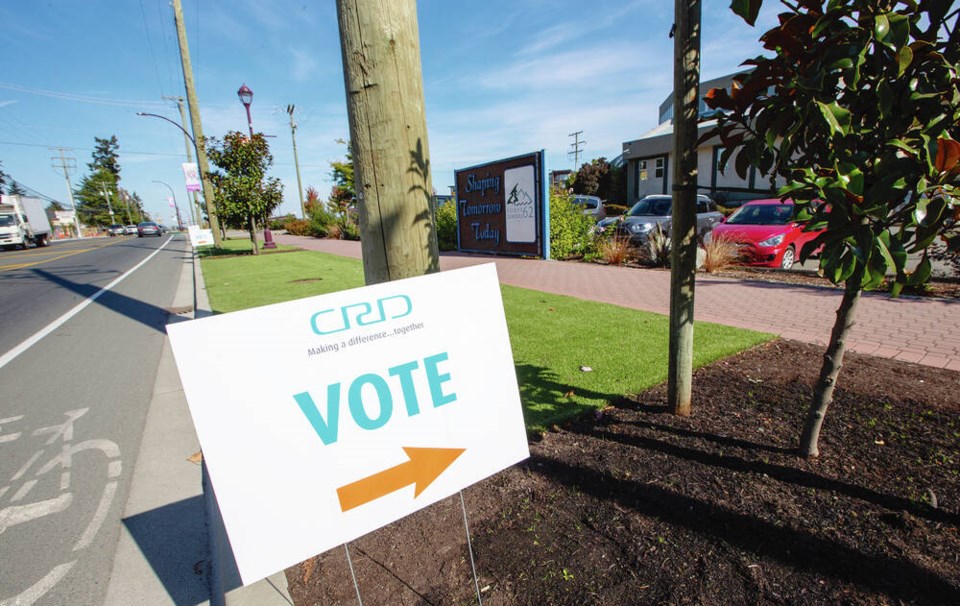It’s local election day across B.C. today. Polls close at 8 p.m. Buyer’s remorse begins at 8:01.
“Jeez,” you say after the candidate you voted for turns out to be a Satanist (or, worse, a Leafs fan). “That wasn’t in the brochure.”
Making the right choice is important, just like on one of those back-country roads where the sign reads: “Pick your rut carefully, because you’ll be stuck in it for the next four kilometres.”
Except in this case you can substitute “years” for “kilometres.” You’ll live with today’s results until 2026.
It’s daunting, though. In Greater Victoria, a total of 264 people are running for 13 municipal councils, three school boards and the CRD.
Among the story lines to watch:
Victoria vacancies
The longest-running soap opera this side of Coronation Street is about to get a whole new cast. Not only is Mayor Lisa Helps bowing out, but the candidates to replace her include incumbent councillors Marianne Alto and Stephen Andrew, meaning that one (or, less probably, both) of them will be out of office, too. Of the remaining councillors, only Ben Isitt is running for re-election. That kind of exodus is unprecedented.
The Saanich mayoralty
Some of this year’s municipal ballots look like take-out menus. In Victoria, eight people are running for mayor and 37 for council. In Nanaimo, it’s four and 29, even without the Jersey Shore Meets House Of Cards council dysfunction that preceded the 2018 election/intervention in Vancouver island’s second-most populous municipality.
Sooke, the 13th largest, has three and 23(!), while even the Island’s smallest municipality, Zeballos, has nine candidates wrestling over four seats in a village of 126 souls.
But while the Island’s largest municipality, Saanich, has 22 council candidates, the only ones running for mayor are incumbent Fred Haynes and Dean Murdock, who served three terms on council prior to 2018. In a year of crowded fields, this one’s a straightforward two-horse race.
Slates
This election has seen the emergence of the Vancouver Island Voters Association, which is running seven candidates for Victoria council and six for school board. The newly formed group has also provided a rallying point for self-described progressives who see a right-wing threat in VIVA, tracing ties to the People’s Party of Canada and vaccine-mandate protesters.
In Sooke, a similar effort has four council candidates and three school board candidates grouped under electionsforchange.ca, though they say they are not a formal slate but a group of like-minded people.
Meanwhile, the Together Victoria name that was attached to three left-leaning Victoria councillors in 2018 has vanished from the ballot.
Langford
Speaking of slates, how about the fastest-growing city in B.C.? For years, Langford elections have been more like a coronation for Stew Young et al, a predictable outcome that in 2018 probably contributed to the 19 per cent voter turnout, the lowest in Greater Victoria.
But with the population growing by a third in five years, the result is harder to predict this time. A slate called Langford Now is challenging Young’s Community First Langford group of four incumbents and two newcomers. Two other incumbents are running independently.
How to take part
BTW, here’s the 2018 voter turnout for the capital region’s other 12 municipalities: Oak Bay 54 per cent, Sidney 49, Victoria 45, North Saanich 44, Metchosin 44, Sooke 42, Saanich 38, Central Saanich 33, Colwood 32, Esquimalt 30, View Royal 25. Highlands seats were filled by acclamation
So, how do you take part? The rules are the same throughout B.C.: To vote, you must be at least 18 years old, be a Canadian citizen and have lived in B.C. for at least six months. You vote in the municipality in which you live, though people who reside in one community but own property in another can cast a ballot in both places. (Only one non-resident vote per property, though, and no voting for properties in which corporations have a stake.)
If you’re not already registered, you may do so today by bringing two pieces of personal ID, including one with your residential address and at least one with your signature, to one of the polling places in your municipality. The municipality’s website can tell you where they are.
That’s it. Go vote. You won’t get another chance until 2026.
jknox@timescolonist.com
> For more election news and candidate information, go to timescolonist.com/civic-election
>>> To comment on this article, write a letter to the editor: letters@timescolonist.com



